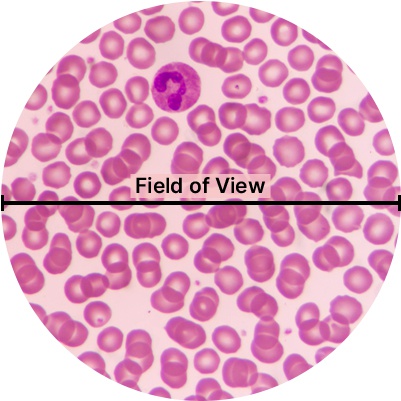How to Estimate the Field of View of a Microscope
What is the Field of View on a Microscope?
Field of view (also abbreviated as FOV) for a microscope is the extent of the observable area in distance units. The optics provide a clear and undistorted view in a field around the optical axis, and the field of view is selected from this. The rays that produce the image in this view are generally aberration-free and do not create a significant falloff in image intensity.
Field of view microscope definition in simple terms it is the area you see under the microscope for a particular magnification. Say, for example, you are viewing a cell or specimen under an optical microscope. The diameter of the circle that you see is the field of view of the microscope.

As you increase the magnification, the field of vision is reduced. Depending upon the lens system, this can vary. A crude way of measuring the field of view is by using a ruler under the microscope for a particular magnification.
How to Calculate Microscope Field of View

To calculate the field of view of microscope you need to know the eyepiece magnification, field number and objective lens. Once you have this information you can calculate the field of view of the microscope by dividing the field number by the magnification number.
Field of View Formula:
Field of View = Field Number (FN) ÷ Objective Magnification
When you switch eyepieces or objective lenses, ensure to repeat the FOV calculations with the new inputs on field number and magnifications. For objects that require higher magnifications, convert your measurements from millimeters to micrometers.
Higher power lenses will allow you to view tiny objects, so the angle of view will be small; low power lenses will do the opposite and let you view bigger (wider) objects.
Learn more about microscope magnification here.
If using a stereo microscope with an auxiliary lens, the magnification factor of this lens should also be employed in the equation by multiplication with the objective magnification. You will have to multiply the eyepiece magnification by the objective magnification to find the total magnification before dividing the field number.
Field of View = FN ÷ (Objective Magnification x Auxiliary Lens Magnification)
For instance, if your eyepiece reads 10X/22, and the magnification of your objective lens is 40. First, multiply 10 and 40 to get 400. Then divide 22 by 400 to get a FOV diameter of 0.055 millimeters.
Why is Field of View Relevant for Microscopes?
The Field of View on a microscope determines the size of the imaged area. It gains importance when you want to measure specifics such as densities -for example, an experiment to estimate the density of cells in a solution. To get the answer, you have to acquire an image of a Field of View, count the number of cells and divide it by the imaged area. The result would be an estimate of cells/micron.
Note that the extent of the Field of Vision depends on the magnification. Objectives with higher magnifications have smaller Fields of Vision. Thus, the size of the Field of Vision should be selected as a function of the size of the features that are to be studied. Bacteria are smaller (around 5 microns) than most human cells (a brain's astrocyte can have 90 microns in diameter). Therefore, to study astrocytes larger Fields of Vision are necessary.
When you record the image to a digital medium the FOV can be expressed as a distance (e.g., 1 mm) or in calibrated pixel counts (e.g., 1024 pixels at 1 um/pixel) along the major axis.
You can learn about microscopes on our other informative pages below:
- What is a compound microscope?
- What is a stereo microscope?
- What is a digital microscope?
- What is a fluorescence microscope?
- How to use a microscope
New York Microscope Company offers a wide selection of microscopes for various applications. We also offer accessories such as replacement bulbs, eyeshields, cell counters and slides. Call our toll free number 877.877.7274 or email info@nyscopes.com to get in touch with a microscopy expert to answer any queries on microscopes or orders.
